ILM Reveals Star Wars: The Force Awakens’ Most Complicated Visual Effects
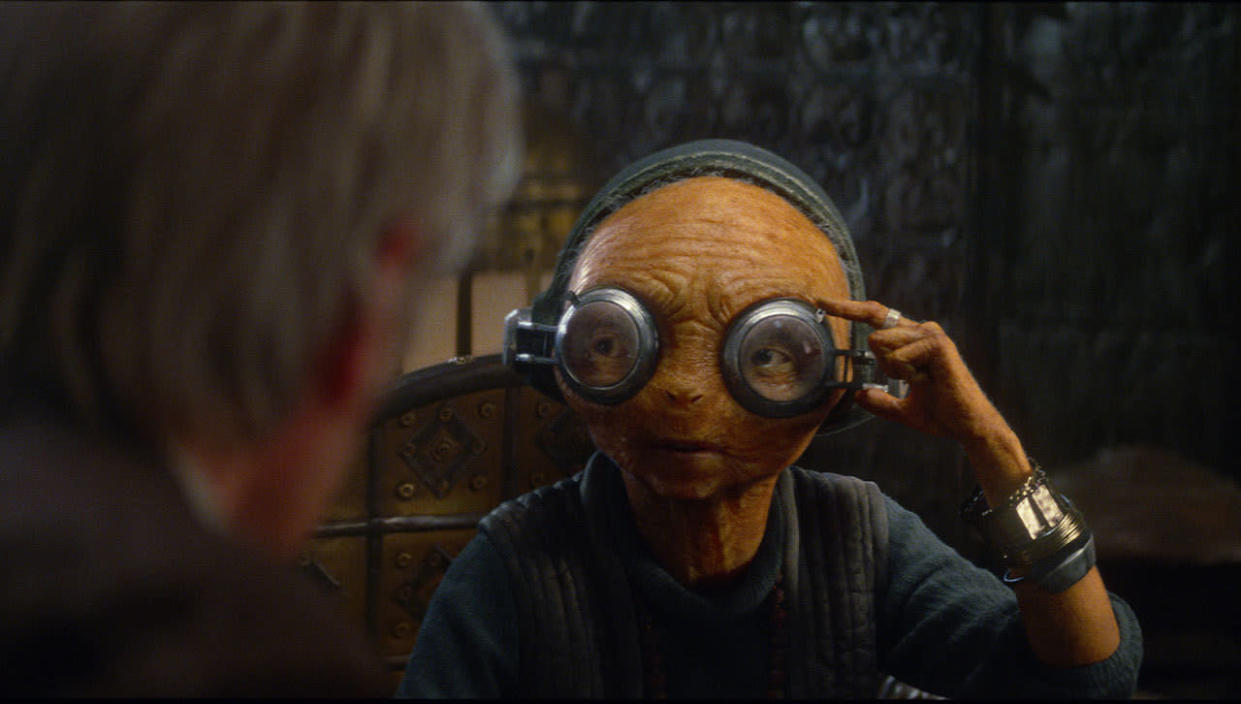
ILM’s newly opened London office completed over 200 VFX shots on ‘Star Wars: The Force Awakens’ and was responsible for bringing CGI characters Supreme Leader Snoke and Maz Kanata to life, but the most challenging shot they worked on involved no aliens, spaceships, or explosions. It centred on making a corridor look realistic.
The scene in question happens partway through the film when Han, Rey, and Finn approach Maz’s castle. ILM had to stitch together three plates, shot in different locations, but it’s likely you never even noticed the shot that took ILM London over 1000 hours to create.
- The Martian VFX: Before and After
- SPECTRE’s VFX Revealed
“That would be a fairly typical VFX shot,” explains ILM’s Compositing Sequence Supervisor Scott Pritchard, “you take all these different elements and layer them together, making it look like it’s all one image.”
“All that will be completely invisible to audiences but it’s a huge amount of work. But when you go to the cinema, you see it up there on screen, and you see your name in the credits: that’s a huge payoff.”
We spoke to Scott following his presentation at Escape Studios’ 2016 VFX Festival where we talked more about what made that particular shot so complicated, the challenges posed by Snoke and Maz, and the hidden VFX you never spotted in the film’s iconic final scene.
Can you talk about the work ILM did for the “Jedi Temple” scene right at the end of the film?

It was shot on Skellig Michael, a tiny island off the west coast of Ireland, so there was a fair amount of work putting the Millennium Falcon in there. There was one shot where you had Rey looking back at the Falcon and R2 and Chewie are down by the entrance ramp. The footage of Rey was shot in Newbury in Berkshire at Greenham Common Air Force base where the Resistance Base was set up. They had a full size partial Falcon set built there, so they shot Rey looking back at that set, and they put a blue screen behind Rey so we could extract her from the plate.
Then we had the background shot on Skellig Michael and we composited that together, then completed the rest of the Falcon with our CG Falcon.
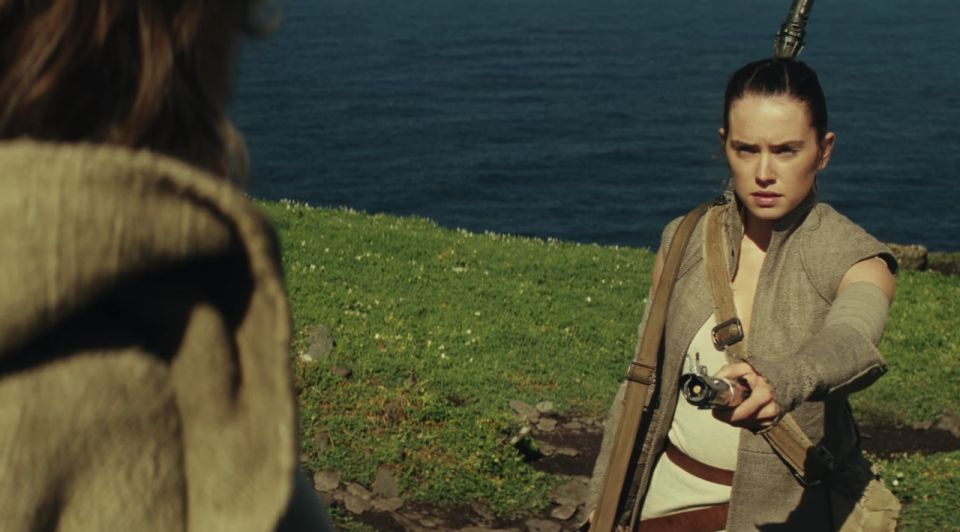
The sea we wanted to just augment slightly, to make it a little bit more dramatic as it was quite a calm day then, so we replaced the sea with a fully CG sea with some interactions, waves splashing up on the rocks, things like that. Then we put some mountains, other islands, in the background as well.
One of the things about Skellig is that it’s a puffin reserve, so there are millions and millions of puffins. There were a lot of puffins nesting on the ground and we had to paint them all out, then put in a lot of CG alien-style birds that we designed and rigged up and put them in there flying around.
What was the most challenging VFX shot you worked on?
The shot where Rey, Finn & Han enter Maz’s castle was one of our most complex. It was stitched together from three separately filmed plates. Well over 1000 hours of work went into this one shot alone.
It’s a shot that starts off just outside the courtyard, and they’re walking away from the camera and there’s this big robot walking out of screen right towards the camera. Then the camera follows them, tilts up, you see all the flags and Maz’s statue, and then it tilts back down again. There are 180 unique flags in this shot; all of them have significance in the ‘Star Wars’ universe. For each flag we had a complete back-story on what it was supposed to be, and what it meant.
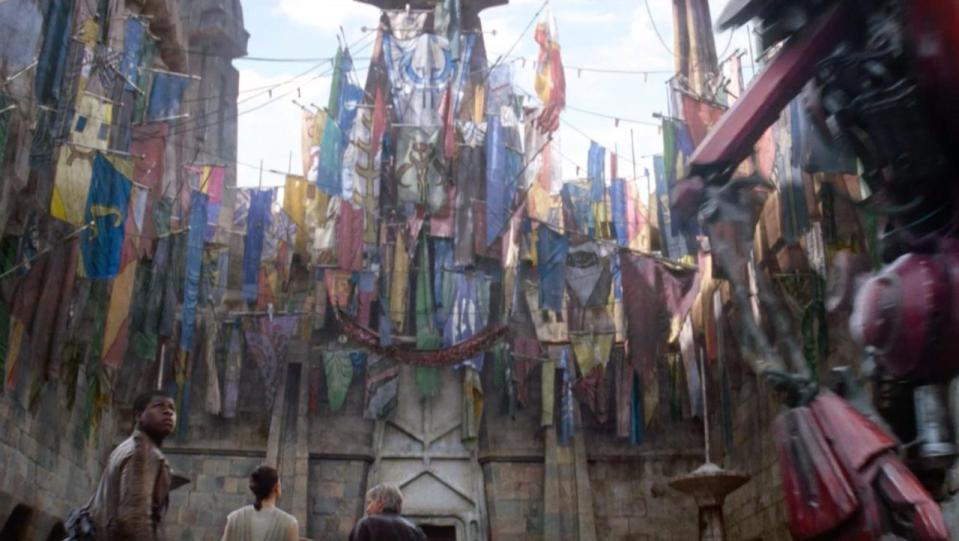
So, up to the tilt up, that’s one plate. Then after the tilt, that’s a second plate when it comes down. That’s a completely different plate that they shot there, then the camera follows us up to the castle doors.
Han says “don’t stare… at anything”, and the doors open and then we follow them into the castle interior and that’s the third plate. In the second plate, basically the doors of the castle open and there’s just a blue screen beyond that.
Then they built a set for the interior of the castle and they tried to match the third plate to try to go through a separate set of replica doors into the castle and then leading up to Maz. Stitching all those together and especially getting the camera moves right was a huge amount of work.
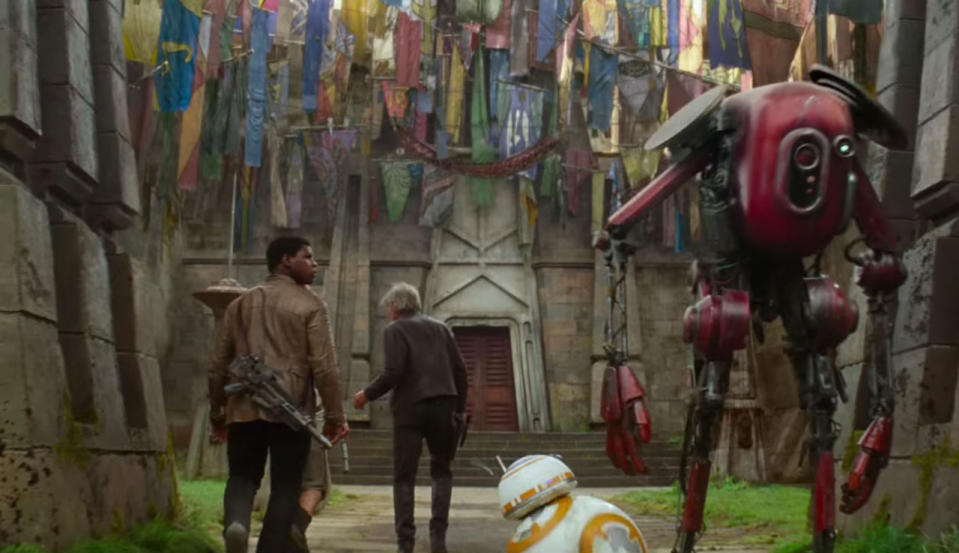
The most complex thing it that whole shot from a stitching point of view was the transition between the interior and the exterior because the camera moves didn’t quite match up. So we had to do a lot of rebuilding of the interior of the castle.
In the plate you might have noticed that Han goes through the doors and immediately turns left, but unfortunately that would have had him walk straight into the lap of this big creature that’s sitting there inside the castle, so we had to remove him and create a space for Han to walk into.
So that whole interior section just inside the door was completely reworked and remodeled to accommodate all that.
What scenes had special effects that you might not expect?
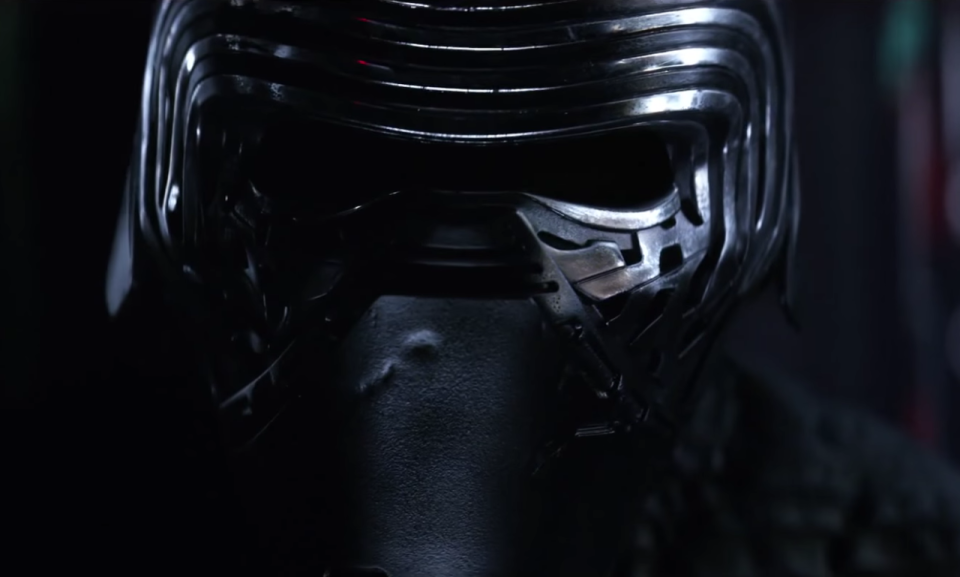
Two sequences featured Kylo Ren and General Hux in Snoke’s briefing chamber. In the original scenes, Adam Driver, who played Kylo, wasn’t wearing his helmet.
JJ later decided to delay the reveal of Kylo’s face until his scene with Rey, so we put a CG helmet on Adam for every shot inside the chamber.
What was the most challenging aspect of bringing Lupita Nyong’o’s Maz Kanata to life?
Maz was about creating a character that sat within the castle environment and interacted directly with the other characters. Her design was quite different from Lupita, so the main challenge was to ensure that Lupita’s characteristics and performance were carried through to the CG Maz.
Maz’s eyes are such an important part of her character, how did you make sure you got them right?
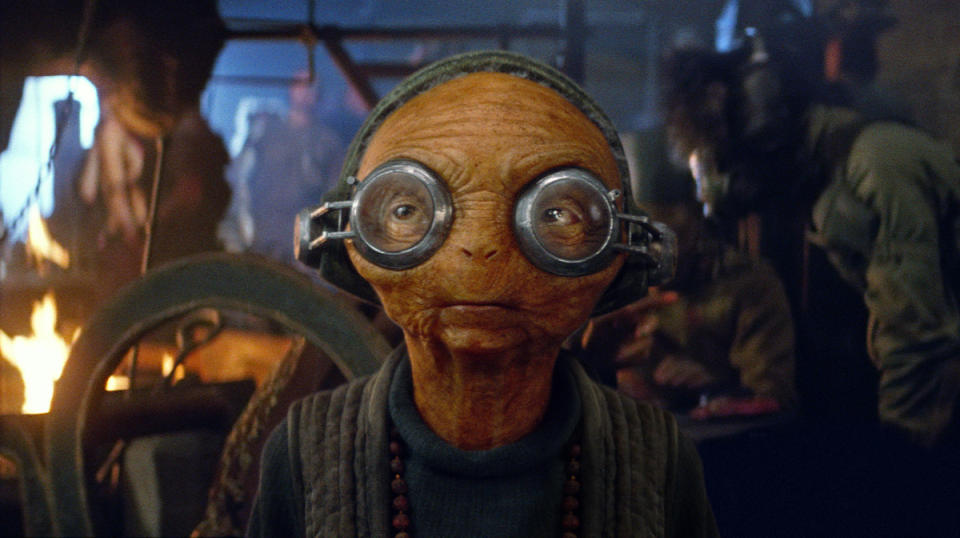
Being part of Disney we’re actually very lucky in that we have access to work by the Disney research group in Zurich. They had done a study into the shape of eyeballs by actually digitally scanning real eyeballs, so we were able to use that to inform our build of the eyeballs and the eyeball socket structure as well, which was great, just to be able to build some accuracy in there.
- JJ’s Biggest Star Wars 7 Regret
- Han Solo Comic Revealed
- Star Wars 7′s Bloopers
They also did a separate study into the aqueous nature of the eye interior and we were able to use that to design how Maz’s iris’ dilated and contracted. So the animators were given control over that so they could basically art direct how her eyes would look and connect that to the emotional content of the scene, so there was a huge amount of work done for her eyes.
At the front of the eye is the cornea, which bulges out slightly, and we had a system that actually pushed the eyelid around, the cornea bulge would push the eyelid around when the eyelid was closed.
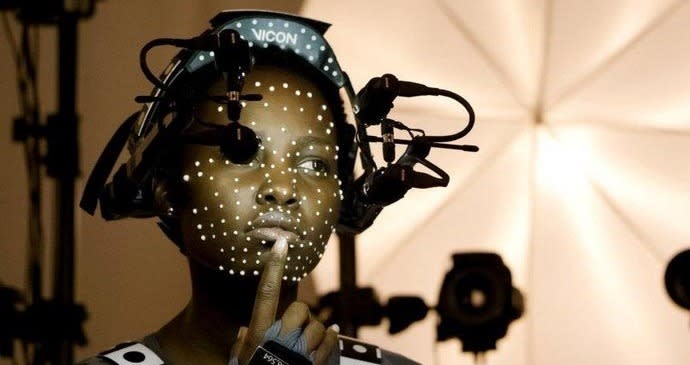
It was tiny little details like that. Maz is all about small details that start to build up. There’s a little layer of fluid, the miniscus, that basically lies between the join between the eyelid and the eyeball and that was all figured out in the 3D department. Just to have that little layer of moisture that would sit there and that gives another layer of reality to her.
Undoubtedly, Maz’s eyes were the centerpiece of her performance and that was definitely a huge amount of her overall work that went into her eyes especially.
They have her goggles on as well, and they had quite a serious amount of refraction in them, so we had to do a lot of work into how much refraction to make it look physically correct, but then you don’t want to take away the performance of her eyes.
For me, the ultimate compliment is for someone not to notice the work. Obviously it’s CG, but if someone can see her as a character, and someone has an emotional connection with the audience, then that means we’ve done our job properly, rather than someone going “she was an amazing CG creature” or “an amazing puppet”.
It doesn’t really matter whether it’s a puppet or an actor in a suit or it’s a CG character, it’s all about conveying a performance and that connecting with the audience. Fundamentally, that’s exactly what it’s all about for us.
What about Supreme Leader Snoke?
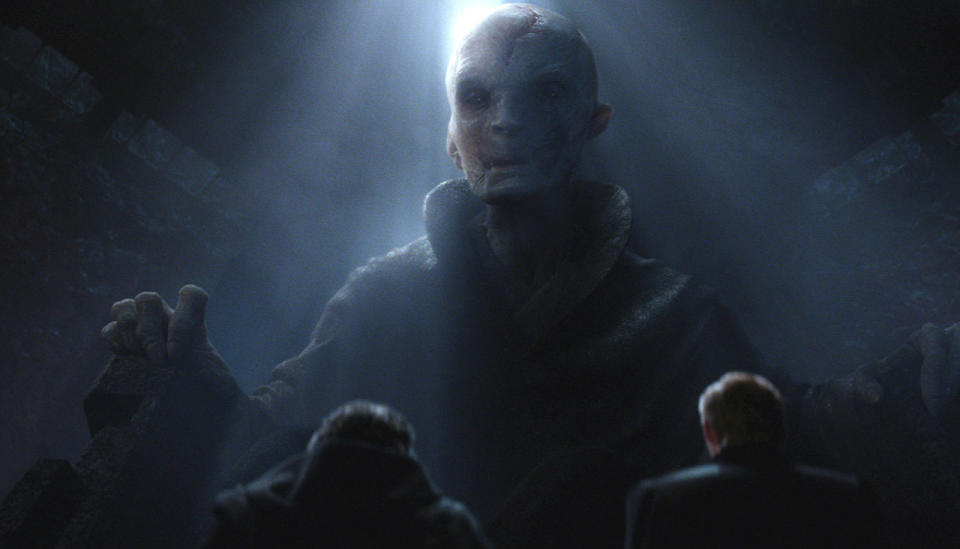
Snoke was more of a straight translation of Andy’s facial performance to the CG character. This required a lot of technical development work to process the facial footage and ensure the information mapped across.
With Snoke we were also more involved in his overall design – we started out with a sculpt that was only finalised during production. JJ asked us to pursue a mysterious, almost diaphanous look for him and we used reference images of jellyfish to explore ideas of a translucent quality to his skin.
His scarring and his eyes both went through a number of design revisions as we got close to final shots.
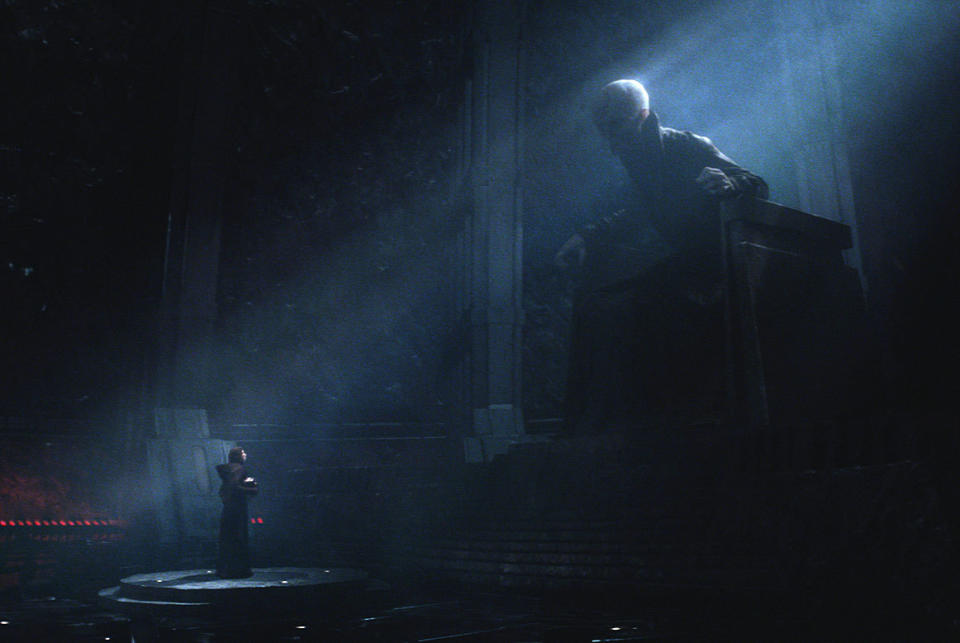
It was a really interesting design challenge because you had this interesting contrast between his fragility, his physical fragility… something pretty awful has clearly happened to him and he’s obviously pretty old at this point. And you had this powerful performance that Andy Serkis gave as well.
It was always JJ’s intention to have him as a hologram and the idea was that you wouldn’t be entirely sure what he was; whether he was real, whether he was in the room.
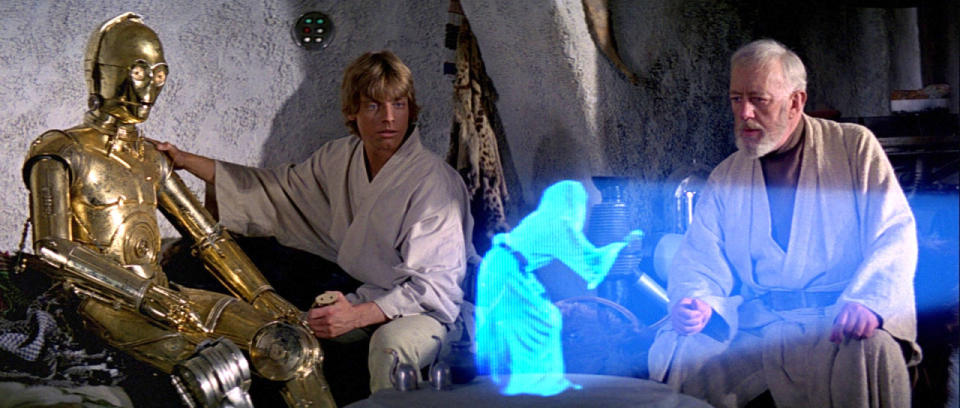
We had a whole bunch of different options for doing holograms. We explored ideas of a 3D hologram, where he would collapse into these different cubes. There’s such a strong graphic element to the ‘Star Wars’ holograms that we ended up building a lot of that into his hologram appearance.
Some of that volumetric cube idea is still in there, but it’s very much rooted in that classic ‘Star Wars’ hologram look.
The prequels are often criticised for having too much CGI, but in fact there are more VFX shots in ‘TFA’ - what’s changed to make people less aware of the CGI?
‘TFA’ relied on practical sets and effects more then the prequels - this meant that although there were more CG shots in TFA, we were working to enhance what was already in camera. Having practical sets and effects was a great help to us as our CG work became more about seamlessly extending or adding to real world locations. They gave a firm grounding to the work we did, and we always worked in co-operation with any practical approach.
In your opinion, what was the most stunning VFX imagery in the film?
I’m a massive X-Wing fan so it was the shot of the X-Wings coming across the water that was in one of the first trailers. It’s just a beautiful shot. The camera’s travelling impossibly fast, I think they’re doing something like 1600mph, something ridiculous, and it’s a beautifully done shot.
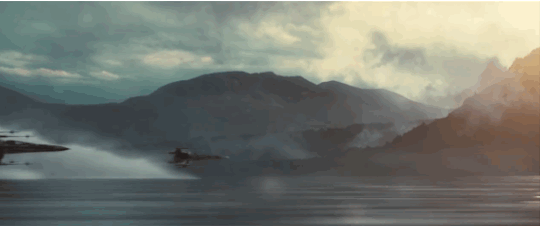
It thumbs right back to the cinematography of the original trilogy. George Lucas’ main reference for that stuff was World War 2 dogfights, archive material, and that’s what he wanted the battles between the X-Wings and the TIE Fighters to reference, to look like and I think this was a classic interpretation of that idea. It’s a beautiful shot and I wish I’d done that one myself.
What did you learn on ‘TFA’ that will help make things easier on ‘Episode VIII’?
Having that complimentary blend of practical and digital work was a great success on TFA, so we’ll be using a similar mix of both approaches on Episode 8.
Has ILM started work on ‘Episode VIII’ or ‘IX’ yet? Are you doing shots for ‘Rogue One’?
We are working on both ‘Rogue One’ and ‘Episode VIII’ already, unfortunately that’s about as much as I can tell you!
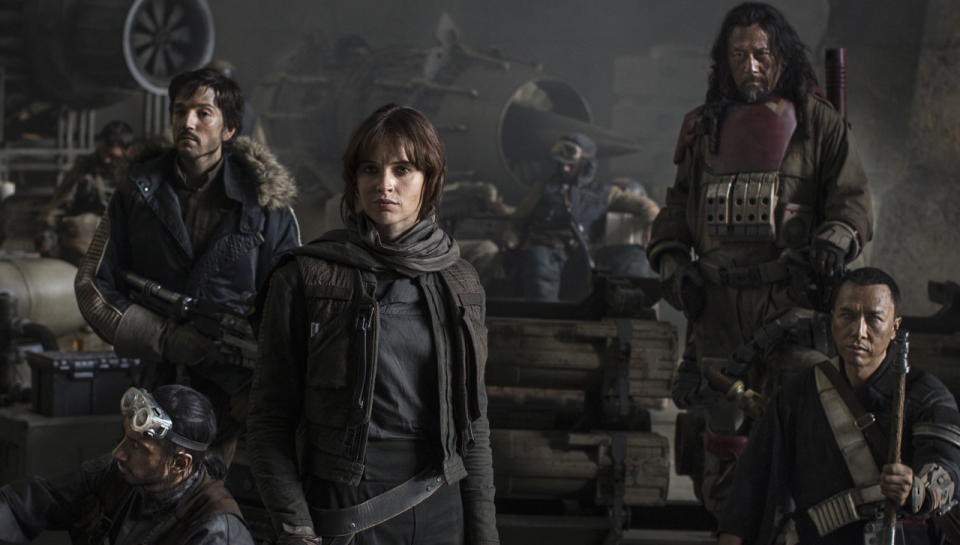
Will ‘Rogue One’ will be aesthetically different to ‘TFA’?
Timeline wise, yes. I have to be careful about what I talk about. It’s definitely in the era of ‘Episode IV’, so there’s all the stuff that people will recognise from the first film absolutely.
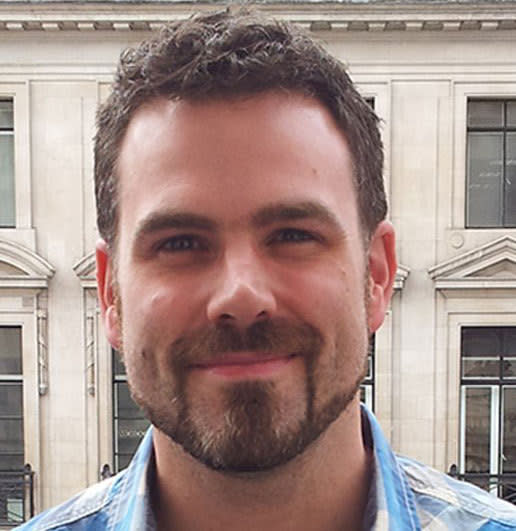
Scott Pritchard (pictured above) is a Compositing Sequence Supervisor at ILM and talked at the 2016 VFX Festival developed by Escape Studios, part of Pearson College London, Europe’s premier visual effects academy.
Find out more: pearsoncollegelondon.ac.uk/es
- 10 More Star Wars Films In Development
- Mind-Blowing Kylo Ren Theory
- R2-D2 Creator Dies
Image credits: Lucasfilm/Disney/20th Century Fox/ILM

